As summer and baseball both begin to wind down, spot bonding is not!
Don’t let the dog days of summer wear your crews down so they are tempted to try this “corner-cutting” method of tile installation. Our industry has worked hard to design and manufacture products for beauty and longevity. This goal also requires using the correct standards, best practices and craftsmanship to deliver installations that will last.
So, what is spot bonding?
Unfortunately, this method is becoming very common. It is – and always has been – an unapproved and discredited practice of placing globs or dollops of bonding mortar under the tile. Typically, these blobs are at the corners and the center of the tile – the classic “five spot” look. This actually creates pillars of mortar that suspend the tile in the air. Anyone conducting tile installation failure forensics will see a lot of this evidence under cracked and broken tiles.
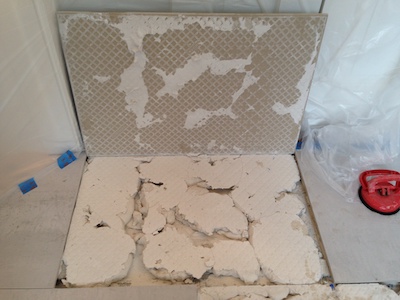
Cement-based bonding mortars are designed for complete contact and wet transfer during installation to provide adhesion and support. Adhesion and mechanical bonds must take place in the matrix of mortar between the tile and the substrate. This explains why mortar coverage requirements for ceramic tile are 80% in dry areas and 95% in wet areas. For stone, it is 95% in all areas and both require full edge and corner support. All of our standards and methods from ANSI, TCNA and NSI agree on these important criteria.
The correct way to set tile and achieve wet mortar transfer is demonstrated in CUSTOM’s and NTCA’s popular training video “Trowel and Error” Please share, share, share this informative six minute video – it is posted on YouTube in three languages and has nearly 12 million views. Find it at: https://bit.ly/3qcynGJ
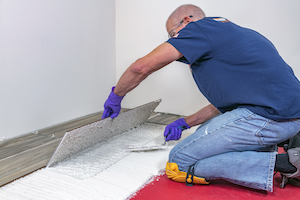

Don’t gamble on your tile installation with spot bonding. But understand that spot bonding is not really a gamble, since failure is not a matter of if – but when – the assembly will fail. Even with a “bonus” type installation of 6 or more spots, this does not equate to full support for the tile body. Tile edges and centers are easily broken by regular foot traffic and service use without the proper, complete mortar support. Without today’s higher breaking strength requirements for floor tiles of 250 lb./in., we would see even more spot bonding failures.
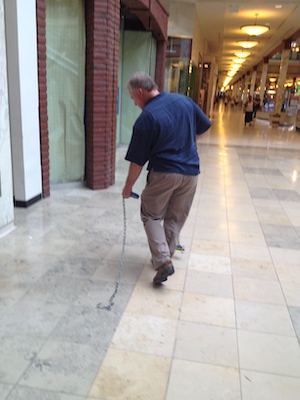

Why does the floor sound hollow here?
Chaining tile floor installations is a method used to detect potential hollow areas, using the sound resonance variances (high to low pitch) that occur with solid support versus no support.
Spot bonding provides very low adhesion values, so it’s easy to understand that with minimized contact there will be reduced adhesion strength when compared to full mortar contact. Reduced adhesion can result in delamination of floor tiles, and even falling tile from vertical and overhead installations.
A tile subjected to stresses beyond what the spot of mortar can provide will succumb to these forces. As the tile moves repeatedly, the grout material is subjected to forces beyond its capacity and will also succumb and crack. This is the beginning of a complete tile assembly failure revealing an inadequately spot-bonded tile installation.
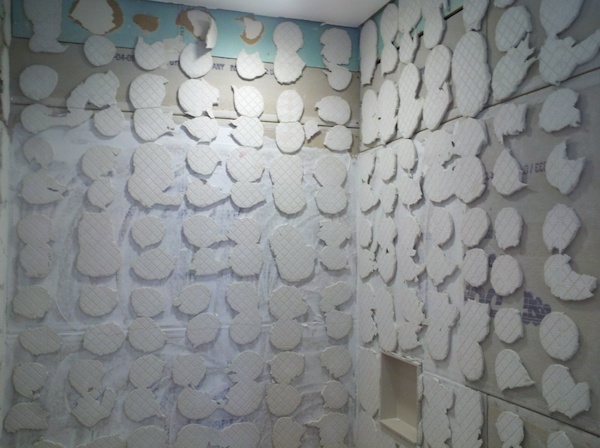

Higher exposure = higher risk
Using spot bonding on an exterior is the biggest gamble of all. Let’s explore why.
Spring/Summer condition: That beautiful summer sun goes to work early in the morning and by mid-day the tile on the building’s veneer can reach temperatures over 150 degrees Fahrenheit. As demonstrated in the Top Five Tips for Movement Joints video on YouTube (https://bit.ly/3Tr3rQ3), hot tiles will expand, and can require up to 8″ of expansion accommodation over a short 90’ span. Think about the amount of pressure this expansion exerts on spot bonding points during this expansion and contraction cycling.


Cement products need water to properly chemically react (hydrate) and gain strength to form strong adhesion with ceramic or natural stone tiles. Heat and relative humidity levels will affect how long water can be retained in anything, much less a cement product that will probably be applied to a hot, dry, absorptive substrate. After the spots of mortar are applied, temps will drop in the evening and reheat tomorrow. Without complete mortar contact, the tile is only minimally restrained while subjected to even faster thermal cycling rates in the tile that was just installed.
When spot bonded, without complete mortar coverage, the high spots will also allow water to flow freely behind the tile installation. (Hopefully at least the waterproofing membrane was installed correctly?…) Gravity guides the water, and as it saturates the spot bonds of mortar, it can erode mineral materials carrying sediment down vertical installations, leaving deposits wherever the moisture leads and evaporates.
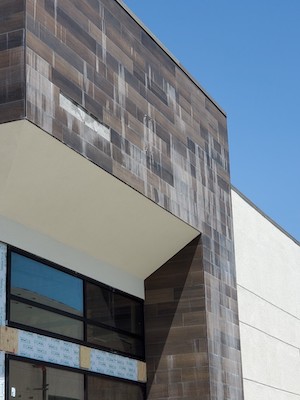

Fall/Winter conditions: While cement-based bonding mortars are primarily designed to provide adhesion and support, the level of polymer additives in modified mortars confer reduced water absorption as an added performance attribute. This is an extreme benefit for exterior applications during wet and colder months, as well as interior wet applications. Again, spot-bonded materials are going to allow movement of moisture behind the tile. As temperatures drop and water freezes, the water will expand as its density decreases; the mass expands approximately 9% by volume. Depending on its state, freezing water can exert a force between about 25,000 and 114,000 psi. Picture how ice cubes grow beyond the level you fill the ice trays and you’ll get the idea.
Imagine how well those spots will hold up to 9% expansion and push stress of over 25,000 psi at the interface of the substrate and the backing of the tile?
Cold weather also slows the hydration of mortar during installation. If the water in the mortar freezes, it creates a destructive change in volume, causing mortar expansion. If the mortar contains more than 6% water, the expansion due to freezing will be great enough to crack the mortar.
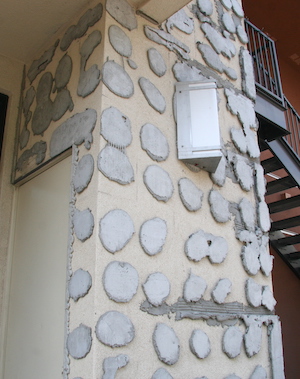

Many exterior spot bonding installations won’t last more than a year when exposed to hot and cold cycling. Failure from spot bonding can be as slow and boring as a crack developing or as dramatic and dangerous as a tile bursting off a wall, falling on a person below.
Hollow sounds from voids, cracked grout and tile, breakage from point load and delamination are all common signs that tile may have been spot bonded. No project owner is going to be happy learning that the contractor left open areas beneath their tile instead of properly bonding it to the surface.
Spot Bonding – Clues of Failure
Floors:
- Hollow floor tiles
- Cracked grout
- Cracked tile
- Delaminating tiles
Walls:
- Cracked grout
- Leaching/efflorescence
- Tiles falling from walls
Let’s all do our part to preserve our industry and keep our customers loving – and ordering more – tile assemblies. Remember, “Friends don’t let friends spot bond!”
Resources:
- LPI: Amazing Expanding Ice – https://bit.ly/3BjUgKE
- InsectAPedia: Mechanics & Forces of Freezing Water – https://bit.ly/3b5nlij
- Physics Forums: Forces exerted by the expansion of freezing H2O – https://bit.ly/3zJ1iYx
- The Balance Small Business: Cold-Weather Masonry and Mortar Tips – https://bit.ly/3OwErDn
- Per Storemyr Archeology & Conservation: Novel micro-images of lime mortar destruction by frost weathering – https://bit.ly/3BiWzh3
Stay tuned for an expanded look at spot -bonding in the October TileLetter!


Will White
Will White CTC/CMT/FCT/ISSI, is the Channel Marketing Director of Technical Support at CUSTOM Building Products. He is an avid supporter of training, improvement and development for the tile and stone industry. He is a member of Tile Council of North America (TCNA), National Tile Contractors Association (NTCA), Materials & Methods Standards Association (MMSA) and American National Standards (ANSI) Committee.







